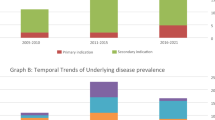Abstract
Direct-current cardioversion is a common treatment modality for acute termination of atrial flutter in neonates. Studies in children have demonstrated that cardioversion is often successful with as little as 0.25–0.5 J/kg with the current biphasic devices. We hypothesize that during cardioversion of atrial flutter in neonates, however, the impedance may be high and more energy may be required for successful cardioversion. A retrospective chart review of our institutional experience from 2005 through 2008 was performed. Neonates with atrial flutter requiring cardioversion who had strips available for review were included. Six patients met the inclusion criteria. The median age at the time of cardioversion was 2.6 h (range, 1.3–336 h) and the mean weight was 3.22 ± 0.4 kg (SD). The mean electrical impedance of the successful shocks was elevated, at 234 ± 136 Ω. The mean energy delivered for successful cardioversion was 0.9 ± 0.3 J/kg, and the current was 1 A in all patients. In conclusion, the shock impedance was elevated in the neonates studied during cardioversion of atrial flutter. Low current was sufficient for successful cardioversion. Further studies are needed in this specific population.

Similar content being viewed by others
References
Atkins DL, Kerber RE (1994) Pediatric defibrillation: current flow is improved by using adult electrode paddles. Pediatrics 94(1):90–93
Atkins DL, Sirna S et al (1988) Pediatric defibrillation: importance of paddle size in determining transthoracic impedance. Pediatrics 82(6):914–918
Batra AS, Hasan BS et al (2006) Efficacy of biphasic waveform compared to monophasic waveform for cardioversion of atrial flutter in pediatric patients. Pediatr Cardiol 27(2):230–233
Casey FA, McCrindle BW et al (1997) Neonatal atrial flutter: significant early morbidity and excellent long-term prognosis. Am Heart J 133(3):302–306
Cornwell L, Mukherjee R et al (2006) Problems with the use of self-adhesive electrode pads in neonates. Resuscitation 68(3):425–428
Dunnigan A, Benson W Jr et al (1985) Atrial flutter in infancy: diagnosis, clinical features, and treatment. Pediatrics 75(4):725–729
ECC Committee, S&A Task Forces of the American Heart (2005) 2005 American Heart Association guidelines for cardiopulmonary resuscitation and emergency cardiovascular care. Circulation 112(Suppl 24):IV1–IV203 [Reprinted: Pediatrics 117(5):e1029–e1038, 2006]
Fogoros RN (1984) Amiodarone-induced refractoriness to cardioversion. Ann Intern Med 100(5):699–700
Fumagalli S, Boni N et al (2006) Determinants of thoracic electrical impedance in external electrical cardioversion of atrial fibrillation. Am J Cardiol 98(1):82–87
Jones P, Lode N (2007) Ventricular fibrillation and defibrillation. Arch Dis Child 92(10):916–921
Kerber RE, Kouba C et al (1984) Advance prediction of transthoracic impedance in human defibrillation and cardioversion: importance of impedance in determining the success of low-energy shocks. Circulation 70(2):303–308
Khaykin Y, Newman D et al (2003) Biphasic versus monophasic cardioversion in shock-resistant atrial fibrillation. J Cardiovasc Electrophysiol 14(8):868–872
Koster RW, Dorian P et al (2004) A randomized trial comparing monophasic and biphasic waveform shocks for external cardioversion of atrial fibrillation. Am Heart J 147(5):e20
Liberman L, Hordof AJ et al (2006) Low energy biphasic waveform cardioversion of atrial arrhythmias in pediatric patients and young adults. Pacing Clin Electrophysiol 29(12):1383–1386
Lisowski LA, Verheijen PM et al (2000) Atrial flutter in the perinatal age group: diagnosis, management and outcome. J Am Coll Cardiol 35(3):771–777
Mittal S, Ayati S et al (1999) Comparison of a novel rectilinear biphasic waveform with a damped sine wave monophasic waveform for transthoracic ventricular defibrillation ZOLL Investigators [see comment]. J Am Coll Cardiol 34(5):1595–1601
Samson RA, Atkins DL et al (1995) Optimal size of self-adhesive preapplied electrode pads in pediatric defibrillation. Am J Cardiol 75(7):544–545
Texter KM, Kertesz NJ et al (2006) Atrial flutter in infants. J Am Coll Cardiol 48(5):1040–1046
Thakur R, Souza JJ, Troup PJ, Chapman PD, Wetherbee JN (1993) Pericardial effusion increases defibrillation energy requirement. Pacing Clin Electrophysiol 16(6):1227–1230
Troup PJ, Chapman PD, Olinger GN, Kleinman LH (1985) The implanted defibrillator: relation of defibrillating lead configuration and clinical variables to defibrillation threshold. J Am Coll Cardiol 6(6):1315–1321
Author information
Authors and Affiliations
Corresponding author
Rights and permissions
About this article
Cite this article
Ceresnak, S.R., Starc, T.J., Hordof, A.J. et al. Elevated Impedance During Cardioversion in Neonates with Atrial Flutter. Pediatr Cardiol 30, 436–440 (2009). https://doi.org/10.1007/s00246-009-9413-6
Received:
Revised:
Accepted:
Published:
Issue Date:
DOI: https://doi.org/10.1007/s00246-009-9413-6




